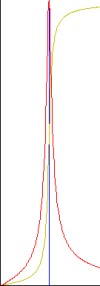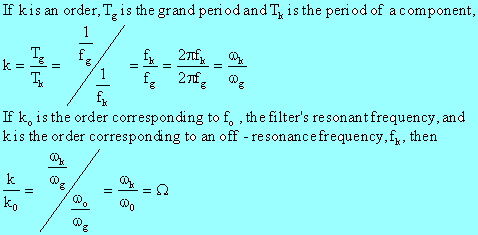A bud λ can be “information-rich”. The information we actually want may well be obscured by other information present in the series. If the wanted information is precisely periodic, then Fourier analysis can often allow it to be extracted: synthesis, from the spectrum of the series, is simply confined to the parts of the spectrum containing the information.
However, a λ time-series is at best quasi-periodic. That is, while its period is not constant, it varies within limits that are “not too large” about some average period (by, “not too large”, we will probably mean that the variation will lie within about plus or minus half this average period). This complicates the spectrum—and the synthesis, as it becomes harder to decide which parts of it contain the wanted information, and whether or not it is “contaminated” by unwanted information.
This difficulty can to some extent be overcome through the use of a resonant filter.
A resonant system is a “tuned” system. Piano wires, guitar strings and organ pipes are examples. They respond most to periodic excitation when the periods of the excitations match their resonant periods.
A radio receiver typically uses a resonant filter to reject signals not at the wanted frequency—but, if that rejection is too good, the filter will also reject the information carried by the transmission. That is, it will reject the speech or music impressed on, or modulating, the “carrier wave”. To avoid this, the filter must pass a certain band of frequencies. We then speak of band- pass filtration.
Now, we can treat the λ variations mentioned above as modulation of a carrier of constant period, and can deal with them using much the same techniques that radio engineers employ.
We may simulate a resonant filter on the computer. We give it the “components” obtained from the Fourier analysis of a bud’s λ time-series to filter. We tailor the filter to have just enough band-pass to retain the variations that accompany it (so that we “hear the music”), and to reject the rest. We cannot do this perfectly, but can do it usefully—and we get the benefits of an adaptive filter. In particular, it preserves from instant to instant in the synthesis the time shifts equivalent to phase shifts.Home Site Map How Tuning is Used
Given that a Fourier analysis has been performed on a bud λ time-series, and that amplitude and phase spectra pertaining to the series have been obtained, then for the purposes of filtration, we can deal with each component as a wave of the form
![]()
where ω = 2πf, in which f is a frequency.
The response of the filter is specified as the sum of g(t) itself, the time-derivative of g(t), and the time-integral of g(t), weighted by (constant) coefficients α, β and γ respectively, as follows:

This is the "resonant" condition.
We now define a Transfer Function, τ, as the ratio of off-resonance to on-resonance filter response:

| The graph of τ will go to a minimum (1.0) at resonance, when Ω = 1, but we want a maximum, so we redefine the Transfer Function τ as the reciprocal of the above quantity, which will go instead to a maximum (also 1.0) at resonance. The graph of this function is approximately bell-shaped. |  |
The larger γβ/α2 is, the more "sharply" the "skirts" of the bell fall away from the maximum: γβ/α2 determines the selectivity of the filter. We do not need to specify α, β and γ individually. Instead, we may put

Thus, a Fourier component of amplitude A will emerge from the filter with an amplitude of τA, and phase-shifted by an angle μ
The order of a Fourier component is given by the ratio of the "grand period" of the data-series under analysis to the period of a single cycle of the component, or by the ratio of the frequency of the component to the fundamental frequency of the series.

We may therefore recast the Transfer Function in terms of Fourier order, k:

A Fourier component of order k may already have a phase of its own, to which the phase-shift due to the action of the filter must simply be added.
The effect of filtration on the whole data series is seen by synthesis:
If A(k) and B(k) are respectively the original cosine and sine coefficients of a component of order k, then

Remarks
A qualitative view is sometimes worthwhile. The filter’s action on a component is defined as the (weighted) sum of (i) itself, (ii) the first derivative of itself with respect to time, and (iii) the integral of itself over a time interval. With some good will, we can think of the first term of the sum as representing the Present, of the second as representing a trend pointing at the Future, and of the last as a record or history of the component’s Past. We can say that the filter “spans the present moment”—or at any rate, does the best it can to do so. It cannot actually predict the future. It can only estimate the future on the basis of the trend in the second term of the definition. And the output pertains strictly to “Now.”
When we look at the bud phase shift, we see that there is a varying “slip”. The buds temporarily change their shapes in the rhythms of the alignments of the moon with their chosen, or allotted, bodies, but not always, and indeed not usually, in synchrony with them. Syncopation, rather than synchrony, appears to be the rule, although there is a slipping from one to the other. And this slipping occurs in such a way that when the buds move out of synchrony, they change their shapes at moments increasingly in advance of the moments of the alignments to which they pertain. It is as if the buds can predict the future, or, alternatively, as if the future is the past for the buds - as if, for them, Time is reversed.
We do not yet know how the buds select their bodies, but it is possible they “tune” to them, rather as a singer tunes to an accompanying instrument, or as a radio is tuned to a station. They would need a tuned filter, such as the one described above, to accomplish this (they would also need a signal to tune to, but that is another tale!). If such is the case, they must in some way be engaged in a process of anticipation on the basis of the now, and of the past.
The point here is that, if they have tuned filters anything like those in radios, they can over-anticipate. The filters need only to be slightly mistuned for this to happen.
I consider the fact that the buds do, apparently, over-anticipate to be excellent evidence that a tuning process of this class is active.